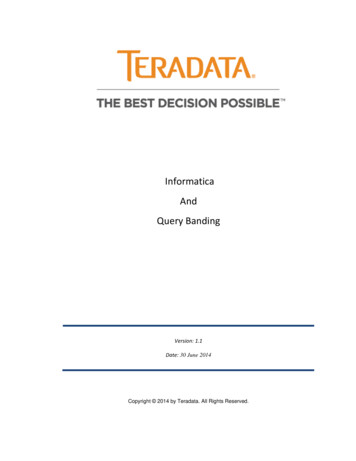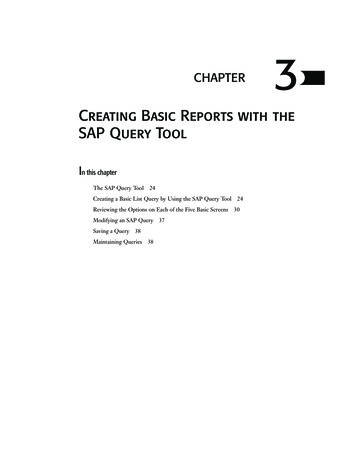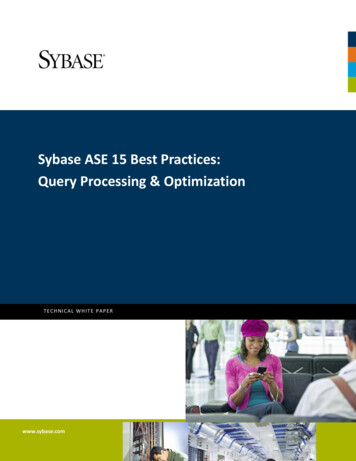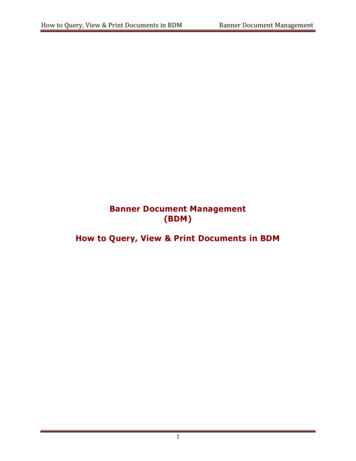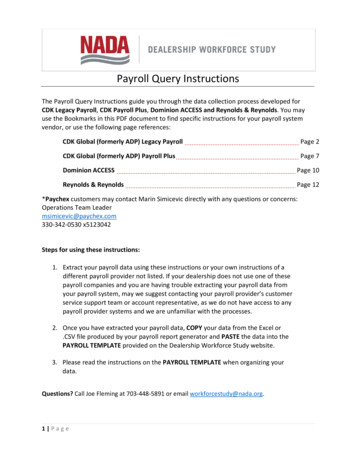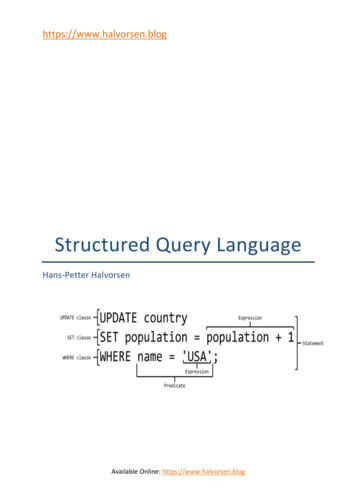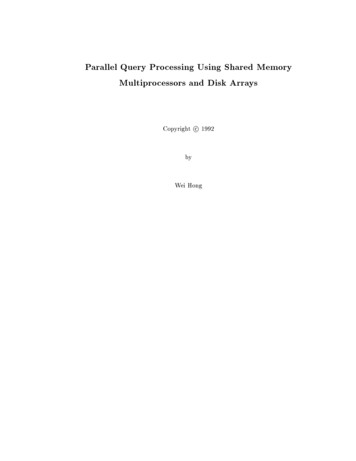
Transcription
Parallel Query Processing Using Shared MemoryMultiprocessors and Disk ArraysCopyright c 1992byWei Hong
iiParallel Query Processing Using Shared MemoryMultiprocessors and Disk ArraysWei HongComputer Science DivisionDepartment of Electrical Engineering and Computer ScienceUniversity of CaliforniaBerkeley, CA 94720August 1992A dissertationsubmitted in partial satisfaction ofthe requirements for the degree ofDoctor of Philosophy in Computer Science inthe Graduate Division ofthe University of California, Berkeley.
iiiTo Nanyan.
ivAcknowledgmentsMy deep gratitude rst goes to my research advisor, Professor Michael Stonebraker,for his guidance, support and encouragement throughout my research. His inexhaustibleideas and insights have been of invaluable help to me. He has taught me to catch the essencein a seemingly bewildering issue and to develop a good taste in research.I worked with Professor Eugene Wong during my rst two years of study in Berkeley. I bene ted immersely from his judicious advising and his rigorous research style. I amvery grateful to him.I would like to thank the members of my thesis committee, Professors RandyKatz and Arie Segev, for taking the time to read my thesis and providing me with severalsuggestions for improvement.I have enjoyed working with all the other members of the XPRS and Postgresresearch group, in particular, Mark Sullivan, Margo Seltzer, Mike Olson, Spyros Potamianos,Je Meredith, Joe Hellerstein, Jolly Chen and Chandra Ghosh. I cherish the time that Ispent with them arguing over design decisions and agonizing over the \last" bug in oursystem. I am grateful for all the help that they have given me in my research. I will alsoremember that it was from them that I learned how to appreciate a good beer and enjoy agood party.I would like to thank my fellow students Yongdong Wang and Chuen-tsai Sun fortheir valuable friendship and for all their help. I also would like to thank Guangrui Zhu andYan Wei for being two special friends and making my life more interesting. Many thanks
valso go to my college friends Yuzheng Ding and Jiyang Liu. Our communications havealways been an inspiring source in my life.Although my parents and my sister are an ocean away, they have o ered me theirconstant love and encouragement throughout my study. I would like to take this opportunityto thank them for everything they have done for me.Last, but the most, I would like to thank my dear wife, Nanyan Xiong. Withouther love, understanding and support throughout my Ph.D. program, this thesis would nothave been possible. This thesis is dedicated to her as a small token of my deep appreciation.
viContentsList of Figures1 Introduction1.1 Query Processing in Parallel Database Systems1.1.1 Conventional Query Processing : : : : :1.1.2 Parallel Query Processing : : : : : : : :1.2 An Overview of Previous Work : : : : : : : : :1.2.1 Shared Nothing Systems : : : : : : : : :1.2.2 Shared Everything Systems : : : : : : :1.2.3 Optimization Algorithms : : : : : : : :1.3 Overview of This Thesis : : : : : : : : : : : : :::::::::2 Optimization of Parallel Query Execution :::::::::::::::::::2.1 Optimization of Parallel Plans : : : : : : : : : : : : : : : : : :2.1.1 The Optimization Problem : : : : : : : : : : : : : : : :2.1.2 Two Phase Optimization : : : : : : : : : : : : : : : : :2.1.3 Introduction of Choose Nodes : : : : : : : : : : : : : : :2.1.4 Intuition Behind Hypotheses : : : : : : : : : : : : : : :2.2 XPRS Query Processing : : : : : : : : : : : : : : : : : : : : : :2.2.1 Implementation of Intra-operation Parallelism : : : : : :2.2.2 Performance of Intra-operation Parallelism : : : : : : :2.2.3 Architecture of Parallel Query Processing in XPRS : : :2.3 Veri cation of Hypotheses : : : : : : : : : : : : : : : : : : : : :2.3.1 Choice of Benchmarks : : : : : : : : : : : : : : : : : : :2.3.2 Experiments on the Bu er Size Independent Hypothesis2.3.3 Experiments on the Two-Phase Hypothesis : : : : : : :2.4 Summary : : : : : : : : : : : : : : : : : : : : : : : : : : : : : :3 Parallel Task ::::::::::::::3.1 Problem De nition : : : : : : : : : : : : : : : : : : : : : : : : : : : : : : : :3.2 Adaptive Scheduling Algorithm for XPRS : : : : : : : : : : : : : : : : : : :3.2.1 IO-bound and CPU-bound tasks : : : : : : : : : : : : : : : : : : : 06263
vii3.2.2 Calculation of IO-CPU Balance Point : :3.2.3 Dynamic Adjustment of Parallelism : : :3.2.4 Adaptive Scheduling Algorithm : : : : : :3.3 Evaluation of Scheduling Algorithms : : : : : : :3.4 Optimization of Bushy Tree Plans for Parallelism3.5 Summary : : : : : : : : : : : : : : : : : : : : : :::::::::::::::::::::::::::::::::::::::::4.1 Notations and Problem De nition : : : : : : : : :4.2 Memory Allocation Strategies for Hashjoins : : : :4.2.1 Cost Analysis of Hashjoins : : : : : : : : :4.2.2 Optimal Memory Allocation for Hashjoins :4.2.3 Dynamic Memory Adjustment in Hashjoin4.3 Integration with Task Scheduling Algorithm : : : :4.3.1 Answer to Question 1 : : : : : : : : : : : :4.3.2 Variation of I/O Rate : : : : : : : : : : : :4.3.3 Modi ed Scheduling Algorithm : : : : : : :4.4 Summary : : : : : : : : : : : : : : : : : : : : : : :::::::::::::::::::::::::::::::::::::::::5.1 Disk Array Con gurations : : : : : : : : : : : : : : :5.1.1 RAID Level 1: Mirrored Disks : : : : : : : :5.1.2 RAID Level 5: Parity Array : : : : : : : : : :5.2 Performance of Parallel Query Processing on RAID :5.2.1 Experiments on XPRS : : : : : : : : : : : : :5.2.2 Experiment Results : : : : : : : : : : : : : :5.3 Summary : : : : : : : : : : : : : : : : : : : : : : : ::::::::::::::::::::::::::::::::::::::::::4 Memory Allocation Strategies5 Performance of Disk Array Con gurations6 Conclusions and Future 04107108109110111112113114121122128
viiiList of .72.82.92.102.113.13.23.33.43.53.6Deep Tree Plan v.s. Bushy Tree Plan : : : : : : : : : : : : : : : : : :An Example Parallel Plan : : : : : : : : : : : : : : : : : : : : : : : : : :Three Basic Declustering Schemes : : : : : : : : : : : : : : : : : : : :Bracket Model of Parallelization : : : : : : : : : : : : : : : : : : : : : :Generic Template for Parallelization in Gamma : : : : : : : : : : : :An Example Split Table : : : : : : : : : : : : : : : : : : : : : : : : : : :The Overall Architecture of XPRS : : : : : : : : : : : : : : : : : : : :Query Plan with Exchange Operators : : : : : : : : : : : : : : : : : :Cost of SeqScan v.s. IndexScan : : : : : : : : : : : : : : : : : : : : : :Cost of Nestloop with Index v.s. Hashjoin : : : : : : : : : : : : : : :Speedup of Parallel Scan: small tup. : : : : : : : : : : : : : : : : : : :Speedup of Parallel Seq. Scan: large tuple : : : : : : : : : : : : : : :Speedup of Parallel Join: small tuples : : : : : : : : : : : : : : : : : :Architecture of XPRS Query Processing : : : : : : : : : : : : : : : :Initial Plan Fragments : : : : : : : : : : : : : : : : : : : : : : : : : : : :Relative Errors of the Bu er Size Independent Hypothesis on theWisconsin Benchmark : : : : : : : : : : : : : : : : : : : : : : : : : : : :Relative Errors of the Bu er Size Independent Hypothesis on theRandom Benchmark : : : : : : : : : : : : : : : : : : : : : : : : : : : : :Relative Errors of the Two-phase Hypothesis on the WisconsinBenchmark : : : : : : : : : : : : : : : : : : : : : : : : : : : : : : : : : : :Relative Errors of the Two-phase Hypothesis on the Random Benchmark : : : : : : : : : : : : : : : : : : : : : : : : : : : : : : : : : : : : : : :A Bin Packing Formulation of the Scheduling Problem : : : : : : :IO-bound and CPU-bound tasks : : : : : : : : : : : : : : : : : : : : : :IO-CPU Balance Point : : : : : : : : : : : : : : : : : : : : : : : : : : : :Page Partitioning Parallelism Adjustment : : : : : : : : : : : : : : :Range Partitioning Parallelism Adjustment : : : : : : : : : : : : : :Experiment Results of Scheduling Algorithms : : : : : : : : : : : : :471113141416203335424344454753545657626466707279
ix4.1 Important Notations in This Chapter : : : : : : : : : : : : : : : : : :4.2 The Hash Table Structure for Hashjoins in XPRS : : : : : : : : : :8797RAID Level 5: Parity Array : : : : : : : : : : : : : : : : : : : : : :Performance of Seq. Scan 8K blocks, Fixed Total Capacity : : :Performance of Seq. Scan 32K blocks, Fixed Total Capacity : :Performance of Index Scan, Fixed Total Capacity : : : : : : : : :Performance of Seq. Scan 32K blocks, Fixed User Capacity : :Performance of Index Scan, Fixed User Capacity : : : : : : : : :Normalized Performance of Index Scan, Fixed User Capacity :Performance of Update Queries : : : : : : : : : : : : : : : : : : : :::::::::::::::
1Chapter 1IntroductionThe trend in database applications is that databases are becoming orders of magnitude larger and user queries are becoming more and more complex. This trend is drivenby new application areas such as decision support, multi-media applications, scienti c datavisualization, and information retrieval. For example, NASA scientists have been collectingterabytes of satellite image data from space for many years, and they wish to run various queries over all the past and current data to nd relevant images for their research.As another example, several department stores have started to record every product-codescanning action of every cashier in every store in their chain. Ad-hoc complex queries arerun on this historical database to discover buying patterns and make stocking decisions.It has become increasingly di cult for conventional single processor computer systems to meet the CPU and I/O demands of relational DBMS searching terabyte databasesor processing complex queries. Meanwhile, multiprocessors based on increasingly fast andinexpensive microprocessors have become widely available from a variety of vendors in-
2cluding Sequent, Tandem, Intel, Teradata, and nCUBE. These machines provide not onlymore total computing power than their mainframe counterparts, but also provide a lowerprice/MIPS. Moreover, the disk array technology that provides high bandwidth and highavailability through redundant arrays of inexpensive disks [37] has emerged to ease the I/Obottleneck problem. Because relational queries consist of uniform operations applied touniform streams of data, they are ideally suited to parallel execution. Therefore, the wayto meet the high CPU and I/O demands of these new database applications is to builda parallel database system based on a large number of inexpensive processors and disksexploiting parallelism within as well as between queries.In this chapter, we rst introduce the issues in query processing on parallel databasesystems that will be addressed in this thesis. Then, related previous work on paralleldatabase systems, especially work on parallel query processing is surveyed. The last sectionof this chapter presents an outline of the rest of this thesis.1.1 Query Processing in Parallel Database SystemsOne of the fundamental innovations of relational databases is their non-proceduralquery languages based on predicate calculus. In earlier database systems, namely thosebased on hierarchical and network data models, the application program must navigatethrough the database via links and pointers between data records. In a relational databasesystem, a user only speci es the predicates that the retrieved data should satisfy in a relational query language such as SQL [26], and the database system determines the necessaryprocessing steps, i.e., a query plan automatically. Since there may be many possible query
3plans which di er by orders of magnitude in processing costs (see [27] for an example), thekey of database query processing is to nd the cheapest and fastest query plan.1.1.1 Conventional Query ProcessingConventional query processing assumes a uniprocessor environment and queryplans are executed sequentially. A query plan for a uniprocessor environment is calleda sequential plan. The common approach to optimization of sequential plans is to exhaustively or semi-exhaustively search through all the possible query plans, estimate a cost foreach plan, and choose the one with minimum cost, as described in [47]. A sequential queryplan is a binary tree of the basic relational operations, i.e., scans and joins. There aretwo types of scans: sequential scan and index scan. There are three types of joins: nestloop, mergejoin and hashjoin. Hashjoin is only useful given a su cient amount of mainmemory [48], hence has not been widely implemented until recently. All other scan andjoin operations, as described in any database textbook such as [30], are applicable in anyenvironments. At run time, the query executor processes each operation in a plan sequentially. Intermediate result generation is avoided by the use of pipelining, in which the resulttuples of one relational operation are immediately processed as the input tuples of the nextoperation.IBM's System R requires the inner relation of any join operation to be a base table(i.e., a stored, permanent relation) [47]. The resulting query plans are called deep tree plans.The rationale is that this restriction allows the use of an existing index on the inner relationof a join to speed up the join processing and reduces the search space of plans signi cantly.In contrast to System R, both the university version and the commercial version of Ingres
R2a deep tree plan1JoinJoinR3R4R1R2JoinR3JoinJoinR4a bushy tree planFigure 1.1: Deep Tree Plan v.s. Bushy Tree Planallow query plan trees of all shapes, i.e., bushy tree plans [59, 29]. Figure 1.1 shows anexample of a deep tree plan and a bushy tree plan for the same four-way join query.There are advantages and disadvantages for both deep and bushy tree plans. Ap-parently, query optimization becomes more di cult as the set of possible plans grows. Theset of bushy tree plans is a superset of the set of deep tree plans, and is larger by severalorders of magnitude. More precisely, the number of all possible deep tree plans is n! for ann-way join query, whereas the number of all possible bushy tree plans is n! Cn 1, whereCk represents the k-th Catalan number which counts the number of ordered binary treesJoin4
5of using deep tree plans for queries with a small number of relations. However, a deep treeplan eliminates the possibility of executing two joins in parallel. Therefore, it is importantto consider bushy tree plans in a parallel database system so that parallelism between joinsin the left subtree and those in the right subtree can be exploited. In this thesis, generalbushy tree plans are considered to exploit parallelism.Query optimization usually takes place at compile time. However, in a multi-userenvironment, many system parameters such as available bu er size and number of freeprocessors in a parallel database system remain unknown until run time. These changingparameters may a ect the cost of di erent query plans di erently. Thus, we cannot simplyperform compile-time optimization based on some default parameter values. This issue ofquery optimization with unknown parameters will be addressed in this thesis.1.1.2 Parallel Query ProcessingAs we can see from the previous subsection, each sequential plan basically speci esa partial order for the relation operations. We call a query plan for a parallel environment aparallel plan. If a parallel plan satis es the same partial order of operations as a sequentialplan, it is called a parallelization of the sequential plan. Obviously, each parallel queryplan is a parallelization of some sequential query plan and each sequential plan may havemany di erent parallelizations. Parallelizations can be characterized in the following threeaspects. Form of Parallelism
6We can exploit parallelism within each operation, i.e., intra-operation parallelismand parallelism between di erent operations, i.e., inter-operation parallelism. Intraoperation parallelism is achieved by partitioning data among multiple processors andhaving those processors execute this same operation in parallel. Since intra-operationdepends on data partitioning, it is also called partitioned parallelism. Inter-operationparallelism can be achieved either by executing independent operations in parallelor executing consecutive operations in a pipeline. We call parallelism between independent operations independent parallelism and parallelism of pipelined operationspipelined parallelism. Unit of ParallelismUnit of parallelism refers to the group of operations that is assigned to the sameprocessor for execution. We also call a unit of parallelism a plan fragments since it isa \fragment" of a complete plan tree. In theory, a plan fragment can be any connectedsubgraph of a plan tree. Degree of ParallelismDegree of parallelism is the number of processes that are used to execute a planfragment. In theory, the degree of parallelism can be greater than the number ofavailable processors.Figure 1.2 shows an example parallel plan. It illustrates the above three aspectsfor a parallelization of a mergejoin plan. As we can see, one input to the mergejoin isa sequential scan followed by a sort and the other input is an index scan. We choose to
R1partitioned parallelismSeqscanSeqscanSeqscanindependent parallelismR2Figure 1.2: An Example Parallel PlanSortSortSortIndexscanIndexscanparallelize the sequential scan and the sort together in the same plan fragment while themergejoin and the index scan are parallelized in separate plan fragments. The sequentialdegree 2scan and sort are parallelized among three processes, i.e., the degree of parallelism is equalplan frag.to 3. Each process scans one third of relation R1 and sorts the quali ed tuples fromthe sequential scan. Similarly the index scan is parallelized between two processes, eachpipelined parallelismscanning half of relation R2. (The details of how to parallelize a sequential scan or index scanwill be described in Chapter 2.) These processes all pipeline their output to the mergejoinparallelism within the sequential scan and sort on relation R1 and the index scan on relationprocess. This parallelization includes all three forms of parallelism. There is partitionedMergejoin7
8than the search space of sequential plans, how to schedule the processing of multiple planfragments in an optimal way, and how to allocate main memory among multiple parallelplan fragments optimally. This thesis presents an integrated solution that addresses allthese new issues.1.2 An Overview of Previous WorkIn the past decade, an enormous amount of work has been done in the eld ofparallel database systems. In the early days, most database machine research had focused on specialized, often trendy, hardware such as CCD memories, bubble memories,head-per-track disks, and optical disks. However, none of these technologies ful lled theirpromises [8]. Parallel database systems did not become a success until the widespread adoption of the relational model and the rapid development of processor and disk technology.Now parallel database systems can be constructed economically with o -the-shelf conventional CPUs, electronic RAM, and moving-head magnetic disks. To date, many successfulparallel database systems have been developed both in the commercial marketplace and inresearch institutions, as will be described in this section.Parallel database systems would not have enjoyed such a big success of todayhad there not
y college friends Y uzheng Ding and Jiy ang Liu. Our comm unications ha v e alw a ys b een an inspiring source in m y life. Although m y paren ts and m y sister are an o cean a w a y, they ha v e o ered me their constan tlo v e and encouragemen t throughout m y study.Iw ould lik e to tak e



